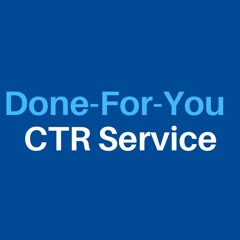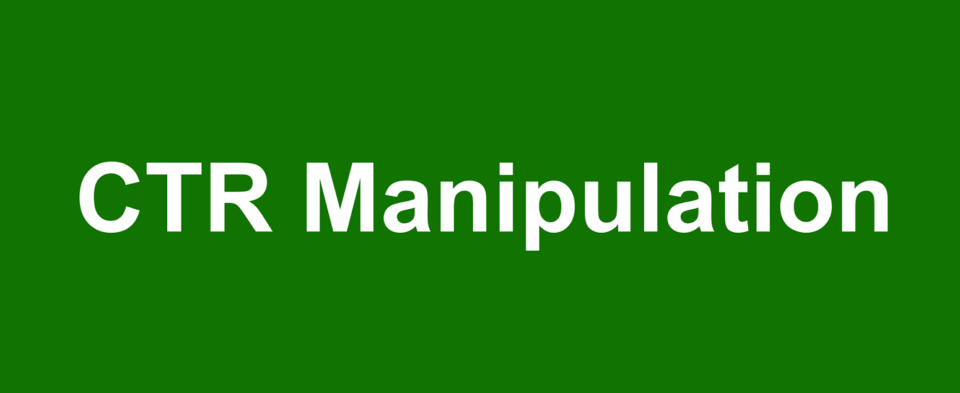The Ultimate Overview to Carrying Out Effective CTR Manipulation Techniques
Attaining Success With Targeted CTR Control
The optimization of click-through prices (CTR) is an important undertaking for brand names intending to enhance their digital visibility and make best use of involvement. Targeted CTR adjustment incorporates a range of techniques, from data-driven ad placements to the growth of compelling material customized to specific audiences. Recognizing the subtleties of individual behavior and using methods such as A/B testing can significantly affect performance end results. The journey to understanding these tactics is complex and requires an ongoing dedication to analysis and improvement. The concern stays: what certain approaches will yield the most considerable results in this vibrant landscape?
Understanding Click-Through Fees
Click-through prices (CTR) work as a vital statistics in digital advertising and marketing, reflecting the efficiency of online material in driving individual involvement. This metric is computed by separating the variety of clicks an advertisement or web link obtains by the total variety of impressions, expressed as a percent (CTR Manipulation). A higher CTR indicates that the content reverberates well with the target market, triggering them to do something about it
Comprehending CTR is important for online marketers aiming to enhance their campaigns. Various variables influence CTR, consisting of ad placement, style, and the significance of the web content to the audience's interests. Compelling headings and visually appealing photos can substantially enhance the likelihood of customers clicking on a link.
Moreover, the context in which the material is provided plays a crucial duty in figuring out CTR. Inevitably, an extensive understanding of CTR encourages marketing experts to improve their strategies, ensuring that electronic projects attain their desired results successfully.
Value of CTR Adjustment
In the competitive landscape of digital advertising, the adjustment of click-through rates (CTR) has become a crucial approach for boosting project performance. CTR offers as a crucial efficiency indicator, reflecting the efficiency of online ads and web content in bring in individual involvement. A higher CTR not only represents higher passion yet likewise can cause boosted search engine positions and reduced cost-per-click (CPC) rates, consequently optimizing overall advertising and marketing budget plans.
The relevance of CTR control lies in its capacity to inform online marketers concerning client choices and behaviors. By examining CTR information, organizations can determine which elements of their projects reverberate most with their target market. This understanding permits more educated decision-making and the allotment of sources to one of the most effective channels.
Additionally, efficient CTR manipulation promotes a competitive benefit. Therefore, mastering CTR control is not merely advantageous; it is essential for attaining continual success in digital advertising and marketing efforts.
Techniques for Targeted CTR
Attaining targeted click-through rates (CTR) needs a calculated approach that includes numerous techniques customized to specific target market sectors. One reliable technique is maximizing ad positionings by using data analytics to recognize high-performing channels. By concentrating initiatives on these networks, marketing experts can improve exposure and increase interaction.
Another important approach is crafting compelling headings and phones call to activity (CTAs) A/B screening different variations can disclose which combinations resonate most with the target audience, therefore driving higher CTR. In addition, incorporating aesthetic aspects such as distinctive pictures or video clips can significantly boost charm, making web content a lot more shareable and engaging.
Customization likewise plays a crucial duty; utilizing individual information to create tailored material can foster a sense of relevance, motivating clicks. Leveraging social proof with testimonies and user-generated material can construct count on, inevitably increasing CTR.
Analyzing User Habits
 Understanding individual behavior is vital for enhancing advertising approaches and boosting general efficiency. By examining how individuals engage with material, marketers can obtain beneficial insights right into choices, motivations, and discomfort factors. This knowledge allows the advancement of more targeted projects that reverberate with details audience sections.
Understanding individual behavior is vital for enhancing advertising approaches and boosting general efficiency. By examining how individuals engage with material, marketers can obtain beneficial insights right into choices, motivations, and discomfort factors. This knowledge allows the advancement of more targeted projects that reverberate with details audience sections.To properly evaluate user habits, different devices and methodologies can be utilized. Web analytics platforms give data on customer interaction metrics such as click-through rates, bounce prices, and time spent on page. Heatmaps and session recordings permit online marketers to picture individual communications, revealing which components bring in focus and which might be overlooked.
Additionally, customer comments through studies and responses types can offer qualitative understandings, improving the understanding of customer view and complete satisfaction. Segmenting users based on habits, demographics, and passions can even more fine-tune targeting initiatives, customizing content to meet diverse requirements.
Eventually, continuous analysis of user habits is crucial for adapting marketing techniques in real-time. As user patterns evolve, remaining attuned to these changes makes certain that campaigns continue to be effective and appropriate, promoting a much deeper connection with the target market. This foundational understanding establishes the phase for the effective application of targeted CTR manipulation techniques.
Measuring Success and Adjusting Techniques
Measuring success in targeted advertising projects requires a calculated technique that integrates performance metrics with continuous analysis. Secret efficiency indications (KPIs) such as click-through rates (CTR), conversion rates, and client acquisition costs need to be checked continuously to evaluate the efficiency of adjustment approaches. By establishing a baseline, marketing professionals can analyze modifications in CTR and determine fads that suggest effective interaction or possible imperfections.
Consistently assessing these metrics permits the timely modification of approaches. As an example, if a particular project reveals a significant decrease in CTR, it might signify the demand for creative alterations or a reevaluation of targeting specifications. Employing A/B screening can additionally improve strategies by contrasting variations of advertisements or touchdown pages, giving insight into what resonates ideal with the target market.
Furthermore, incorporating qualitative feedback through surveys or customer interviews can supplement measurable data, using a thorough sight of target market assumption. Eventually, the capacity to iteratively analyze and refine approaches based on real-time data promotes a much more responsive advertising and marketing technique, ensuring that campaigns remain straightened with service goals and audience preferences. This flexible technique is important in accomplishing sustained success in read what he said targeted CTR adjustment.
Conclusion
In final thought, targeted CTR control is essential for optimizing electronic advertising initiatives. By recognizing click-through visit this web-site rates and using tactical strategies, brand names can successfully enhance user involvement and drive conversions. Continuous analysis of customer habits and persistent dimension of performance signs facilitate prompt changes, guaranteeing placement with consumer preferences. Ultimately, successful CTR adjustment not only increases exposure but also fosters count on and integrity, thereby adding to sustained growth in affordable markets.
 Targeted CTR control encompasses a range of methods, from data-driven ad positionings to the advancement of engaging material tailored to details target markets.Click-through prices (CTR) serve as an essential metric in digital advertising and marketing, showing the efficiency of on-line web content in driving customer involvement. A greater CTR shows that the web content resonates well with the target audience, triggering them to take action.
Targeted CTR control encompasses a range of methods, from data-driven ad positionings to the advancement of engaging material tailored to details target markets.Click-through prices (CTR) serve as an essential metric in digital advertising and marketing, showing the efficiency of on-line web content in driving customer involvement. A greater CTR shows that the web content resonates well with the target audience, triggering them to take action.CTR serves as a crucial performance image source sign, reflecting the performance of on-line advertisements and content in bring in user involvement.In final thought, targeted CTR control is essential for enhancing digital advertising initiatives.